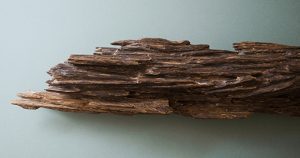幽玄の香りを放つ香木(愛知県名古屋市千種区姫池通 骨董買取 古美術風光舎)
2024.06.18
沈香は乱獲を防ぐため、現在ワシントン条約により規制されています。

伽羅はベトナム山間部の森林地帯半径数十キロ内という限られた地域でしか産出されません。再良質の伽羅はもう採取できないため樹木の宝石といわれています。
自然が作り上げた幽玄な香りは人々を引き付け、日本でも昔から貴重な香料として皇族や貴族、戦国武将などの間で重用されてきました。現在1グラムで数万円の価値があり、金よりも高価なものとされています。
そして伽羅の中でも最も有名な香木として知られているのが、奈良の正倉院に収められている「蘭奢待(らんじゃたい)」です。正倉院の約9000の宝物の中でも最も注目されている品とされています。

正倉院展資料より
全長1.5メートル、最大直径43センチ、重量11.6キロの大きさで、中は空洞で樹脂が溜まり表面が黒くなっています。「甘、酸、辛、苦、鹹(塩辛い)の五味の全てを持ち合わせ、香木の頂点とされています。
この「蘭奢待(らんじゃたい)」の3文字には、それぞれ「東」「大」「寺」の文字が隠されています。東大寺を火から守るという意味が込められているとも伝えられています。正式名称は「黄熟香(おうじゅくこう)」です。
歴代の天皇や将軍たちが手柄のあったものに、この木を切り取って与えたことで、この木を持つものは権力者であるというイメージに繋がっていきました。切り取った個所には名前が貼られ、足利義満、足利義教、足利義政、織田信長、明治天皇などの名前が記されています。
織田信長は時の天皇の許しを得て、1574年3年28日に蘭奢待を切り取りました。5.5センチほどの欠片を2片、東大寺の大仏師に切りとらせたと伝えられています。一片を天皇に献上し、さらに天皇は公家に譲り毛利輝元にも渡りました。信長は千利休などの茶人に譲るなど、蘭奢待は香りを楽しむというよりは権力を示す役割を強くしていきました。
蘭奢待の香り、一体どのようなものなのでしょうか?想像ばかりが膨らみます。一説には「杏仁」の香りにも似ているとのこと。永遠に叶わないものへの興味や憧れが一層強くなります。
次回は香文化がどのように発展していったのかを綴りたいと思います。
それでは、また次の機会に。
Hello everyone. This is Staff H.
Recently, I often hear the word “inbound”. The number of travelers from overseas to Japan is increasing dramatically. What is it about Japan that attracts people from other countries? When thinking about what attracts foreigners to Japan, many people may cite the various traditional cultures that have been handed down from generation to generation.
Among them, there are “flower arrangement,” “tea ceremony,” and “kodo,” which are collectively known as the “three traditional arts. Kodo is not as familiar as flower arrangement and tea ceremony, and may be difficult to imagine. It is said that the reason for this is that fragrant wood, the main ingredient of Kodo, is difficult to obtain and is very precious.
In this article, I would like to write about the types of fragrant wood and their history.
-What is fragrant wood?
A fragrant tree is a tree that emits its own fragrance, and in Japan, it is called “agarwood,” “kyara,” and “sandalwood. I would like to write about agarwood and sandalwood.
Aloeswood
The oldest historical book in Japan, Nihonshoki (Chronicles of Japan), records that in the 3rd year of Suiko (595), islanders made firewood from a large piece of driftwood that had washed ashore on what is now Awaji Island. The driftwood was a tree that grew naturally in Southeast Asia. It was called “agarwood” because it was heavy enough to sink when placed in water, and this is the origin of the name “agarwood.
Agarwood is collected from trees of the Zingiberaceae family that grow wild in Vietnam, Thailand, Indonesia, Malaysia, Cambodia, etc. Various environmental conditions combine to produce a precious aromatic tree whose fragrance is released when the resin accumulated over several hundred years matures together with the fibers of the tree.
The fragrance varies depending on the region of origin, but it is a fragrant wood with a refreshing bitter, sweet, and pungent taste.
It is said that Buddha loved the fragrance of agarwood and often burned it.
Agarwood is currently regulated by the Washington Convention to prevent overharvesting.
Successive emperors and shoguns cut down the tree and gave it to those who were successful, leading to the image that the owner of the tree was a powerful person. Names were affixed to the cut areas, including those of Ashikaga Yoshimitsu, Ashikaga Yoshinori, Ashikaga Yoshimasa, Oda Nobunaga, and Emperor Meiji.
It is said that Oda Nobunaga, with the permission of the Emperor of Japan, had two 5.5 cm pieces cut out by the Great Buddha Master of Todaiji Temple on March 28, 1574. One piece was presented to the emperor, who gave it to a court noble, and the other to Terumoto Mori. Nobunaga gave it to tea masters such as Sen no Rikyu.
What kind of fragrance is Lanjatai? One can only imagine. One theory is that it is similar to the scent of “apricot. My interest and longing for something that will never come true becomes even stronger.
In my next entry, I would like to write about how the incense culture developed.
Agarwood is mainly divided into Tani and Siam.
Those from Thailand, Vietnam, and Cambodia are called “Siam agarwood” and are characterized by a sweet, sour, and slightly bitter aroma, while those from Indonesia and Malaysia are called “Tani agarwood” and are characterized by a pungent and slightly sweet aroma.
The highest grade of agarwood is called “Kyara”.
Kyara
Kyara is produced only in a limited area within a few dozen kilometers radius of a forest area in the mountains of Vietnam. It is said to be the jewel of trees because it can no longer be harvested in the same quality as the original Kyara.
The ethereal fragrance created by nature attracts people, and in Japan, it has long been valued as a precious fragrance by the royal family, aristocrats, and military commanders of the Warring States period. One gram of Kyara is currently worth tens of thousands of yen and is considered more expensive than gold.
The most famous of all Kyara fragrant woods is “Ranjatai,” which is housed in the Shosoin Repository in Nara. It is considered the most remarkable item among the approximately 9,000 treasures in the Shosoin.
It is 1.5 meters long, 43 centimeters in diameter at its widest point, and weighs 11.6 kilograms. It has all of the five tastes and is considered to be the pinnacle of fragrant woods.
The three characters of this “Ranjatai” are hidden in the words “East,” “Great” and “Temple,” respectively. It is said that the characters are meant to protect Todai-ji Temple from fire.
See you next time.
*******************
ご実家の整理やお片付けなどをされている方のご相談などが多くございます。
お片付けなどくれぐれもご無理のないようになさってくださいませ。
風光舎では古美術品や骨董品の他にも絵画や宝石、趣味のお品など様々なジャンルのものを買受しております。
お片付けをされていて、こういうものでもいいのかしらと迷われているものでも、どうぞお気軽にご相談下さいませ。
また風光舎は、出張買取も強化しております。ご近所はもちろん、愛知県内、岐阜県、三重県その他の県へも出張いたします。
まずは、お電話お待ちしております。
愛知県名古屋市千種区姫池通
骨董 買取【古美術 風光舎 名古屋店】
TEL052(734)8444
10:00-18:00 OPEN

